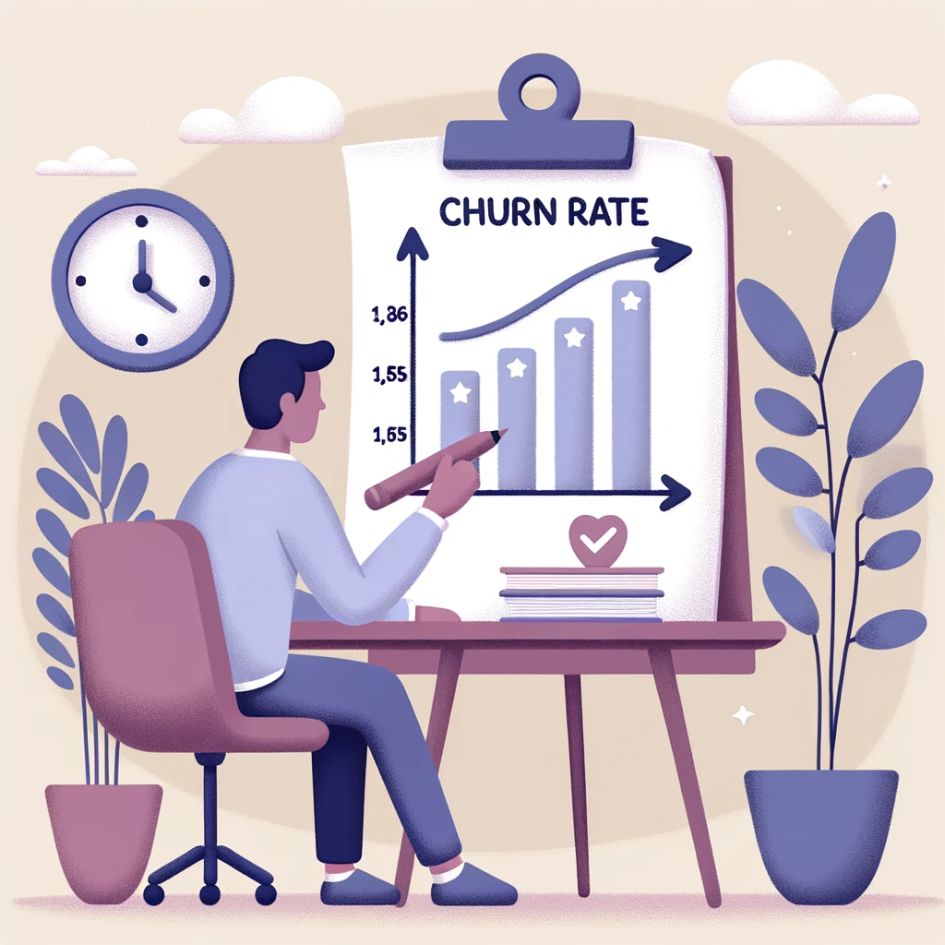Churn rate is a key metric that can make or break a SaaS business. Understanding and reducing churn directly impacts revenue, customer retention, and overall business growth.
But how can SaaS companies effectively measure, analyze, and minimize churn?
In this blog post, we’ll dive deep into churn rate, explore its causes, and share strategies and case studies to help your churn SaaS business thrive.
Key Takeaways
- Churn rate is an essential metric for SaaS businesses to monitor and control.
- Companies can reduce churn by enhancing user experience, providing personalized customer support, and optimizing pricing strategies.
- Tracking key metrics such as customer & revenue churn rates helps companies identify improvement areas and benchmark against industry averages.
The Importance of Churn Rate in SaaS Businesses
The churn rate, which represents the percentage of subscribers who cancel or don’t renew their subscriptions within a certain timeframe, is a vital metric for SaaS businesses.
It signifies customer and revenue losses. For that reason, keeping an eye on and controlling churn is necessary to prevent its potentially negative effects on revenue growth and customer retention.
Grasping the significance of churn rate requires a look into its effects on three major areas: revenue, customer retention difficulties, and the growth and stability of the business.

Revenue Implications
The churn rate directly affects a company’s revenue, making it essential to monitor and minimize. Customer cancellations have a direct influence on a company’s Monthly Recurring Revenue (MRR), making it imperative to monitor and reduce it. An excessively high annual churn rate can severely affect a company’s revenue, hence the need for stringent monitoring and proactive reduction measures.
The monthly churn rate, or SaaS churn rate, is the percentage of recurring revenue that is lost over a given period. This includes failed charges, customer downgrades, and cancellations. On average, it is tracked monthly. SaaS businesses can maximize their net revenue churn and ensure sustainable growth by minimizing churn.
Customer Retention Challenges
Customer retention poses a significant challenge for SaaS businesses, and comprehension of churn rate is beneficial for pinpointing improvement areas, especially when considering how many customers are affected.
In the SaaS business realm, companies are faced with the challenge of customer retention, and SaaS churn can be utilized to identify areas for improvement for existing customers.
SaaS businesses can minimize customer churn by improving user experience, offering personalized customer support, and optimizing pricing and flexibility.
Addressing these obstacles and employing successful approaches allows businesses to improve their customer loyalty and lessen the consequences of attrition on their financial growth and expansion.
Business Growth and Stability
A reduced churn rate aids business growth and stability, thus becoming a crucial performance indicator for SaaS firms. A high churn rate reflects an abundance of customers departing from the business, which can lead to a decrease in revenue and impede growth. It also has an effect on the stability of the business as it becomes more difficult to maintain a steady and expanding customer base.
The churn rate is a vital metric that investors take into account when assessing a company’s stability, growth prospects, and valuation. Hence, lowering the churn rate is essential for business growth and stability. Using better user experience, personal customer help, and good pricing can help businesses keep more customers and succeed in the long run.
Causes of Churn in SaaS Companies
Several factors can induce churn in SaaS companies, such as product fit, customer support, and pricing.
Identifying and tackling these causes can help businesses curb churn and enhance overall customer satisfaction.
To better understand the causes of churn, we’ll explore three main factors: product fit and usability, customer support and communication, and pricing and competitor influence.
Product Fit and Usability
Ensuring a good product fit and usability is crucial for reducing churn in SaaS businesses. If the product does not meet customer needs and expectations, it is likely to cause customers to churn.

Likewise, if the usability of the product is not satisfactory and customers find it difficult to use, they may become discouraged and opt to cancel their subscription. Ensuring a suitable product fit and providing excellent usability allows businesses to reduce churn and hold onto more customers. This involves continually refining the product based on customer feedback and ensuring that it remains relevant and user-friendly.
Customer Support and Communication
Effective customer support and communication can help retain customers and reduce churn. The influence of customer support and communication on churn rate is considerable, as 67% of churn can be avoided if the issue is resolved on the initial contact.
Providing personalized customer support and proactive communication can improve customer satisfaction and help address potential issues before they escalate, thus reducing churn. Investing in a customer success team and implementing tools to enhance communication with customers can significantly contribute to minimizing churn and fostering customer loyalty.
Pricing and Competitor Influence
Competitive pricing and flexibility can help SaaS companies minimize churn caused by competitor influence. Businesses can stay ahead of their competition and retain customers by evaluating the market to ensure their pricing is competitive and considering developing tiered pricing structures.
In addition to competitive pricing, offering flexible plans, such as monthly or annual contracts, can cater to the varying needs of customers and help reduce churn. Ensuring that pricing strategies align with the value customers receive also allows customers to recognize the worth of their purchase, thus decreasing the chance of churn.
Calculating Churn Rate: Methods and Best Practices
Various methods to compute churn rate can yield useful insights into customer behavior and retention. Each method has its advantages and drawbacks, and selecting the most suitable calculation method for your business depends on various factors, such as customer base size, contract duration, and product complexity.
In this section, we’ll discuss three churn rate calculation methods: the simple churn rate formula, cohort analysis, and adjusted churn rate.
Simple Churn Rate Formula
The simple churn rate formula provides a straightforward way to calculate churn but may not account for all factors. The customer churn rate can be calculated by dividing the number of customers who left by the total number of customers and then multiplying it by 100.
While the simple churn rate formula is easy to calculate and understand, it may not accurately reflect the intricacies of customer behavior, such as seasonal fluctuations or specific customer segments. Therefore, it is essential to consider other methods for a more comprehensive understanding of churn.
Cohort Analysis
Cohort analysis offers a more detailed view of churn by examining specific customer segments over time. Companies can gain valuable insights into how different groups of customers behave and identify patterns that may contribute to churn by analyzing churn rates by cohort.
However, cohort analysis can become complex when dealing with a large number of cohorts, making it essential to balance the level of detail with the resources available for analysis.
Adjusted Churn Rate
Adjusted churn rate accounts for growth and other factors, providing a more accurate representation of churn. The adjusted churn rate takes into account growth and other factors to give a more comprehensive representation of churn.
Companies can better understand the true impact of churn on their business and make more informed decisions regarding customer retention strategies and resource allocation by using the adjusted churn rate.
Strategies for Reducing Churn in SaaS Businesses

Deploying strategies to curb churn can aid SaaS businesses in retaining customers and enhancing their profitability. Companies can identify areas for improvement and implement targeted strategies to reduce churn by addressing the causes of churn and utilizing best practices for calculating churn.
In this section, we’ll discuss three key strategies for reducing churn: enhancing user experience, providing personalized customer support, and optimizing pricing and flexibility.
Enhancing User Experience
Improvements in onboarding, product features, and usability to enhance user experience can contribute to reducing churn.
Companies can create a positive user experience that fosters customer loyalty and reduces the likelihood of churn by providing a seamless onboarding process and ensuring that product features are tailored to the user’s needs and preferences.
In addition, investing in usability features, such as intuitive navigation, clear instructions, and helpful tutorials, can further minimize churn and reduce customer acquisition costs by ensuring that customers can easily navigate and use the product.
Personalized Customer Support
Offering personalized customer support and proactive communication can aid in customer retention and churn reduction. Companies can decrease churn by up to 15% by addressing customer issues promptly and efficiently.
Investing in a customer success team and implementing tools to enhance communication with customers can significantly contribute to minimizing churn and fostering customer loyalty. Proactive support enables the identification and resolution of customer issues before they become aware of them, thus providing customers with the assurance that their concerns are being heard and addressed.
Pricing Optimization and Flexibility
Fine-tuning pricing strategies and providing flexible plans can help SaaS companies maintain competitiveness and reduce churn. Here are some strategies to consider:
- Evaluate the market to ensure your pricing is competitive.
- Consider developing tiered pricing structures to cater to different customer segments.
- Offer flexible plans and options to meet the diverse needs of your customers.
Businesses can stay ahead of their competition and retain customers by implementing these strategies.
In addition to competitive pricing, offering flexible plans, such as monthly or annual contracts, can cater to the varying needs of customers and help reduce churn. Ensuring that pricing strategies align with the value customers receive also allows customers to recognize the worth of their purchase, thus decreasing the chance of churn.
Tracking and Monitoring Churn Metrics

The tracking and monitoring of churn metrics is crucial for comprehending customer behaviour and benchmarking against industry norms. Keeping an eye on churn metrics, like customer churn rate and revenue churn rate, helps businesses see how well they’re keeping customers and find places they can improve.
In this section, we’ll discuss the key churn metrics to track and the importance of benchmarking against industry averages.
Key Churn Metrics to Track
Key churn metrics like customer and revenue churn rates offer valuable insights into customer retention.
Monitoring these metrics can help companies identify trends, pinpoint areas for improvement, and set realistic goals for reducing churn.
By closely monitoring key churn metrics, such as:
- Customer churn rate
- Revenue churn rate
- Net revenue retention
- Gross revenue retention
Companies can gain valuable insights into customer behavior and identify areas for improvement.
Benchmarking Against Industry Averages
Benchmarking a company’s churn rate against industry averages can pinpoint improvement areas and facilitate the setting of achievable goals. Industry averages for churn metrics can vary depending on the sector, with the average churn rate across sectors being approximately 5.6%.
Companies can gain insights into their performance compared to their peers and set realistic objectives for growth by benchmarking against industry averages. This information can be used to develop targeted strategies for improving customer retention and reducing churn.
Case Studies: Successful Churn Reduction Efforts
Studying case examples of successful churn minimization can offer valuable insights and strategies for SaaS businesses. Companies like Dropbox, Slack, and Salesforce have effectively implemented strategies such as enhancing product alignment and extended contracts to reduce churn.
Looking at these case studies helps businesses understand what works for others. They can use these lessons to reduce churn, keep more customers, and grow steadily over time.
Summary
Understanding and reducing churn is crucial for the success of any SaaS business. Studying the reasons for churn, measuring it with different methods, and making plans to lower it helps companies keep customers and earn more money.
Continually monitoring key churn metrics and benchmarking against industry averages can also help businesses identify areas for improvement and set realistic goals, ensuring long-term success in the competitive SaaS landscape.
Frequently Asked Questions
What is churn in SaaS?
Churn in SaaS is the rate at which customers cancel their recurring subscriptions, measured as a percentage. For example, if the churn rate is 5%, that means 5% of your customers have canceled their subscription with your company in a given period.
What is a good churn rate in SaaS?
For SaaS companies that target small businesses, a ‘good’ churn rate should be 3-5% monthly, while for enterprise-level products, it should be 1% monthly. These rates are typically lower than the average monthly churn rate of 3-8%, and the average annual churn rate of 32-50%.
How is SaaS churn calculated?
SaaS churn is calculated by dividing the number of lost customers by the total number of customers at the start of the period and multiplying the result by 100. For instance, if a business had 300 customers at the start of the month and lost 20 customers by the end, its churn rate would be (20/300) x 100% = 6.7%.
What are the 4 types of churn?
The four types of churn are customer churn, revenue churn, gross MRR churn, and net churn. A low churn rate is important for achieving success, with a good monthly rate for SaaS businesses being below 1%.
What are some common causes of churn in SaaS companies?
Common causes of churn in SaaS companies include product fit, customer support, and pricing.





